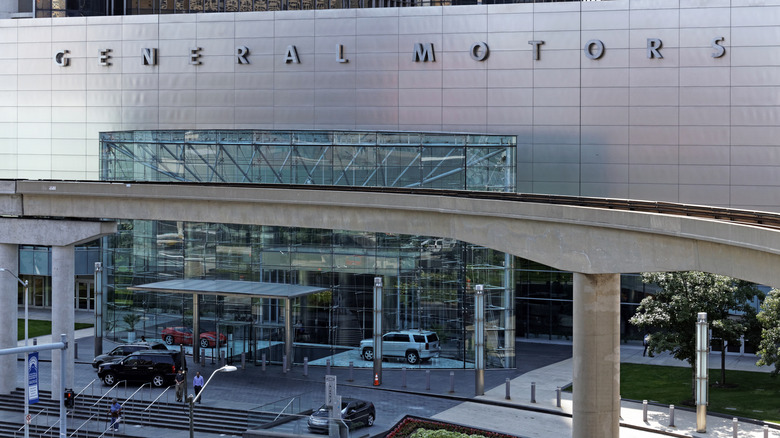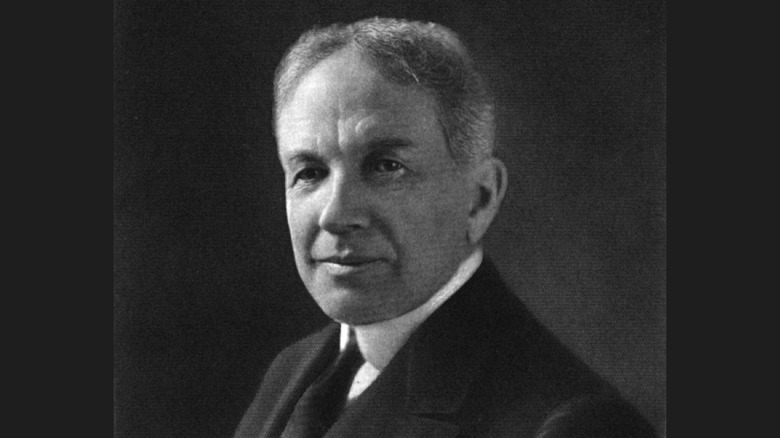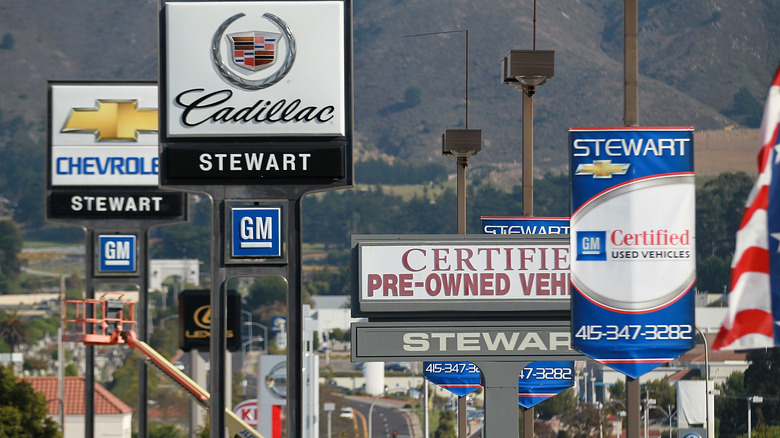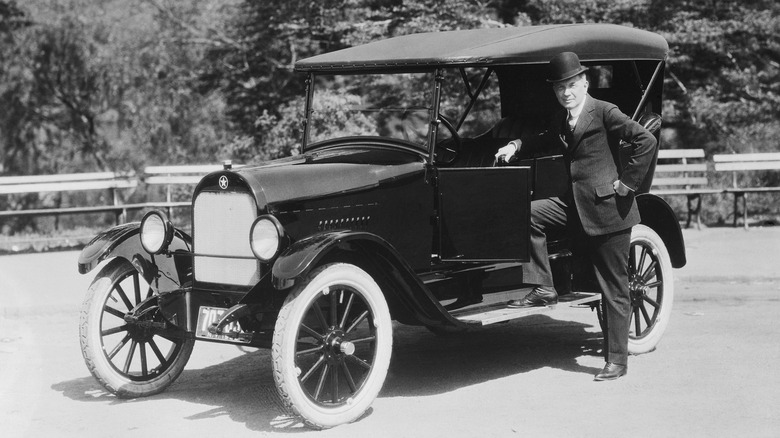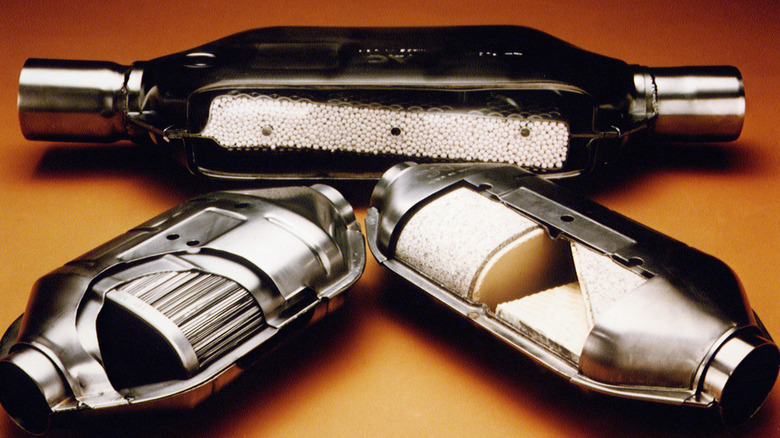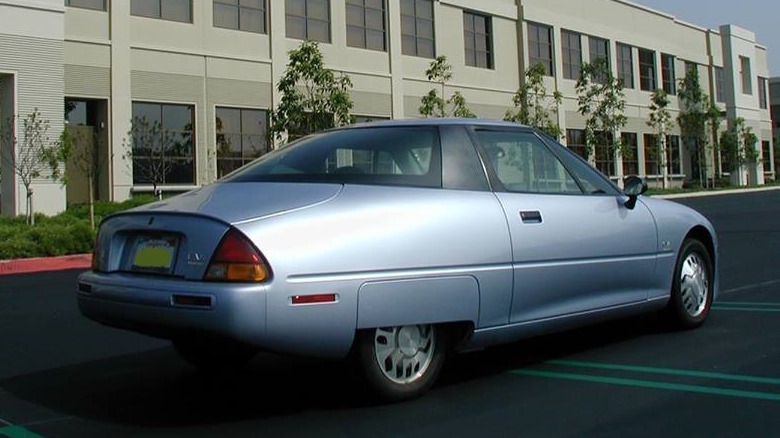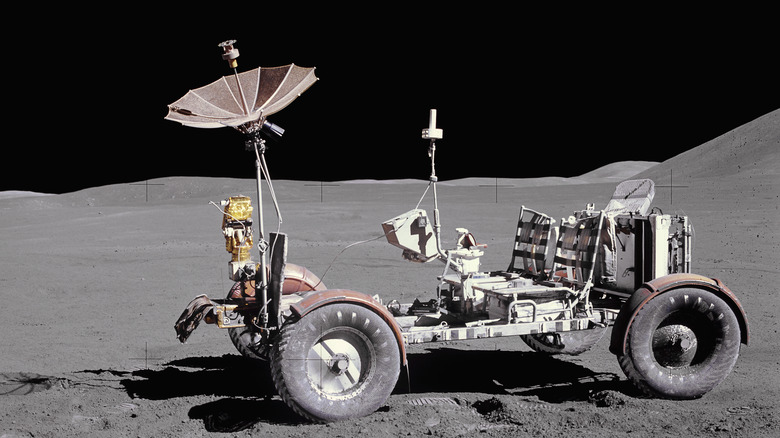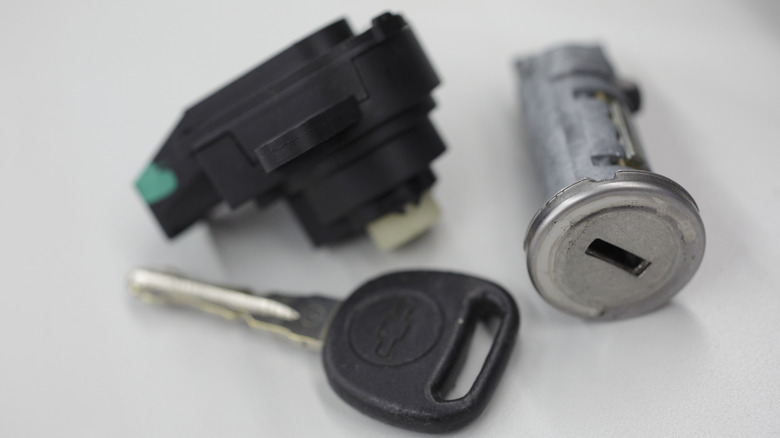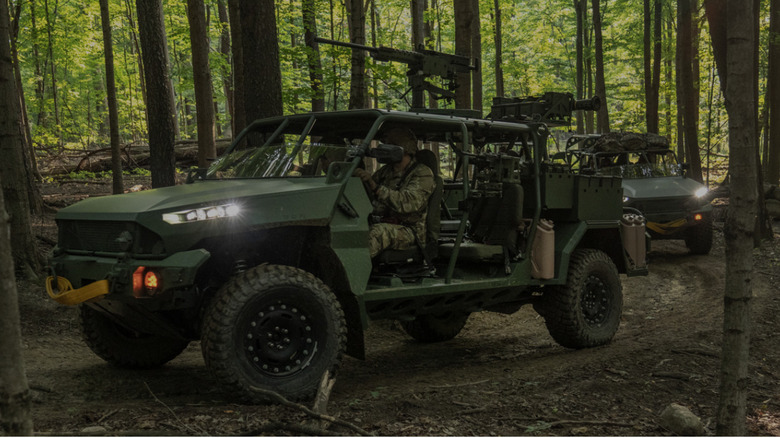10 Interesting Facts Every Car Enthusiast Should Know About General Motors
Founded in 1908, General Motors has been through a lot in its 115 years in operation. What was originally a loose collection of automakers became a worldwide force, and then a bankrupt business, and then the largest automaker in the world all over again.
Born in Flint, Michigan, and headquartered in Detroit, General Motors is one of America's "Big Three" automakers, alongside Ford and Dodge. It's a fascinating company with a rollercoaster of a history — basically, the brainchild of one businessman who saw the value in a diverse lineup of vehicles. Today, GM consists of some of the biggest brands in American automobiles — Chevrolet, Buick, GMC, and Cadillac — as well as communication and infotainment system OnStar, parts-maker AC Delco, Ultum EV solutions, and more. Over its century-plus history, the company was also the owner of companies like Frigidaire, Pontiac, Oldsmobile, Saturn, and Saab. Let's take a look back at some of the more interesting facts about General Motors.
GM's founder wasn't big on the automobile at first
At age 24, William Durant was considered successful. He'd dropped out of school at 17 to work piling lumber and later selling cigars, before getting into the insurance industry. In 1886, he bought a horse cart company for $2000, and by 1901, the Durant-Dort Carriage Company was the largest vehicle manufacturer in the United States.
1900 saw several different horseless carriage companies start to gain traction all over the country. Flint, Michigan, the home of Durant's carriage factory, was in danger of being left behind during that transition. However, hope was available in the form of Buick. The company, founded in 1899, found itself in financial trouble soon after its' establishment. When Buick's new owner asked Durant — who, by that time, was a millionaire — to lead the struggling company, Durant initially wasn't interested, as he believed automobiles were noisy, smelly, and dangerous. However, after driving a Buick for a couple of months, Durant changed his mind and took over Buick in 1904. He would become the controlling investor soon after that, and moved production of Buick from Detroit to Flint by 1905, allowing the company to expand production.
[Featured image by Unknown Author via Wikimedia Commons | Cropped and scaled | CC BY-SA 3.0]
General Motors has always valued variety
The early automobile industry was a bit like the Wild West. Dozens of manufacturers existed, but none really dominated the market, and many took down payments before simply disappearing. Benjamin Briscoe, a metalworks owner and part owner of the Maxwell-Briscoe motor company, thought consolidation was a better option, and pitched it to the owners of Ford, REO, and Buick. Henry Ford wasn't interested, but Durant was — albeit in a different way. He wanted to form a holding company, allowing individual manufacturers to make their own vehicle designs.
That mindset led to the formation of General Motors in 1908, which included Buick and REO's Oldsmobile. In two years, GM would own eleven automakers, including Cadillac, GMC, and Oakland, later known as Pontiac.
GM nearly acquired Ford around that time, as well. Henry Ford, locked in a lawsuit against a patent lawyer he wasn't sure he'd win, agreed to sell for $8 million. Durant didn't have that on hand, and when he went to the National City Bank of New York for a loan of $2 million, they weren't willing to take the risk. GM's board had already given Durant the green light to make the deal; if the bank had agreed to put up the money, automotive history probably would've played out very differently.
While the number of General Motors' brands has diminished, the company has always valued a diverse lineup, as evidenced by some of the strangest GM cars we've covered.
GM's founder was forced out of the company twice
By 1910, Henry Ford's Model T was overwhelmingly America's choice of car. GM offered 21 different models of larger cars, but the public valued the reliability and lower cost of the Ford. As Durant's image suffered, he had to take a five-year loan, meaning banks were in control of his beloved General Motors.
Rather than just wait the time out, William Durant began working with Louis Chevrolet, a racer and engineer who drove for the Buick racing team in 1909. The Buick team dominated, winning half of the road races held in America. Durant suggested Chevrolet design a car, and together they founded the Chevrolet Motor Company in 1911. The shares Durant still held in GM, and the amount of stock he was able to amass with Chevrolet's success, allowed Chevrolet to take a controlling interest in General Motors, and in 1916, Durant was elected president of General Motors once again.
Sadly, the post-WW1 boom came to an end, and Durant's success was short-lived. While he tried to keep the company's stockholders afloat by spending his personal fortune — a fortune already diminished by gambling — he'd need another bailout from banks. That came with the requirement that Durant resign from GM. He'd go on to found Durant Motors, but the company was liquidated by 1933 during the Great Depression. Sadly, William C. Durant's story ended with him going bankrupt and running a bowling alley in a drive-in restaurant in Flint, Michigan.
Innovation is a hallmark of General Motors
General Motors and its parts subsidiary AC Delco have implemented several firsts in the automotive industry. In the 1920s, when GM developed the first Lacquer paint system for cars, which cut 15 days off production time and brought more customization options for GM's customers. Soon after, the company also introduced the battery-based ignition system and electric starter.
Oldsmobile's 1939 Hydra-matic transmission was the first series-built automatic transmission with a torque converter, a design that's still recognizable in today's transmissions. The 1962 Oldsmobile Cutlass Turbo-Jetfire was the first series-produced car with a turbocharger. And 1966 saw the introduction of the Electrovan, GM's concept car that was the first ever to be powered by a hydrogen fuel cell. General Motors also was a pioneer in the use of unleaded gasoline and vehicle structural analysis.
Emissions reduction has been at the forefront of a lot of GM's work. Both the positive crankcase ventilation (PCV) valve and the catalytic converter were developed by General Motors in the 1960s, and were adopted by the automotive industry soon after.
GM's Research and Development teams didn't just innovate for automobiles, either. The company developed a mechanical heart pump, allowing doctors to perform the first open-heart surgery, as well as the room air conditioner, and a machine that allowed for blood and vaccine sterilization.
GM made the first big-name electric vehicle
GM has a history of experimenting with alternative-powered vehicles. We mentioned the Electrovan in our last section, a vehicle powered by a hydrogen fuel cell; GM also produced the Electrovair in 1964, a Chevrolet Corvair fitted with an electric motor and a battery pack. However, it was the 1996 Saturn EV1 that really made a splash — it was the first practical, affordable electric car made by a major manufacturer (and the subject of the 2006 documentary "Who Killed the Electric Car?").
The EV1 was practically overstuffed with innovations that have become commonplace in today's vehicles. Regenerative braking, electrohydraulic power steering, tire pressure sensing, and more were all used in this futuristic vehicle with a weird, rounded body designed for maximum aerodynamics. Unfortunately, it was a good idea ahead of its time.
GM put around a billion dollars into the development of the EV1, but it was a spectacular flop. The lack of a charging infrastructure and a charging time of nearly twelve hours was simply too much to ask of the public. After leasing the cars to VIP customers, GM collected the thousand or so vehicles it had built and had the majority of them crushed. Only 40 remain, either housed in museums or kept for research by GM, with the only fully intact EV1 a part of the Smithsonian National Museum of American History in Washington, DC.
[Featured image by Rob Peirson via Wikimedia Commons | Cropped and scaled | CC BY-SA 3.0]
GM and NASA have a fascinating history together
GM and NASA worked together to develop a number of interesting innovations in both space travel and robotics. The lunar rover used in the Apollo 15 lunar mission, as well as guidance and navigation systems for the entire Apollo Moon program, were made (at least in part) by General Motors.
Upcoming missions in NASA's Artemis program will use a new lunar vehicle developed by GM and Lockheed Martin. The Artemis program, tasked with getting humans back on the Moon for exploration and research, is planning to use a variety of rovers to improve astronauts' mobility.
GM also contributed to robotics for NASA, including the Robonaut 2 — a humanoid robot designed to perform tasks in space their human counterparts cannot. GM's interest in Robonaut is a little more down-to-Earth, as the work it's putting into the robot — things like control, sensor, and vision technology — can be applied to vehicle safety systems, and the robotics can be used in its plants, reducing safety risks to GM's employees. The development of the Robonaut 2 also led to the Robo-Glove, a wearable device that can help reduce the grasping force necessary for some jobs by way of actuators and pressure sensors.
GM's Milford Proving Ground is a 4000-acre test city
General Motors purchased a piece of land between Michigan's Oakland and Livingston counties in 1923. Since then, the site has grown to include a top-secret testing ground and a greenspace providing homes to deer, foxes, fish, and birds. It's a self-contained compound with its own well water, and wastewater treatment. It has its own firefighters, EMTs, road patrol officers, and medical department.
The Milford Proving Ground is where GM engineers get to test drive any number of new innovations on the property's 147 miles of test courses, ranging from dirt roads, to a 3-mile road course designed to replicate Germany's famous Nurburgring, to an intentionally pothole-ridden stretch of concrete. One of the more interesting roads is Belgian Block, a 2-mile-long brick road made to replicate a stretch that ran from Antwerp to Brussels, discovered by American soldiers during World War I. There's also the site's "Black Lake," an asphalt vehicle dynamics pad that's the size of 59 football fields and used to test things like vehicle handling, traction control, braking, and more; its name comes from the habit of local waterfowl to mistake the surface for an actual lake and land on it.
The Proving Ground employs over 4000 workers across 107 buildings, but only a select few get to test GM's vehicles. Of General Motors' over 81,000 global employees, less than 100 have met the requirements to perform top-speed testing at the facility.
Mary Barra is the first woman to lead a major automaker
GM required reorganization after its 2009 bankruptcy alongside Chrysler, and its subsequent government bailout. Arguably the biggest of the company's moves after that turnaround was when General Motors CEO Dan Akerman decided to step down, and Mary Barra was chosen to replace him. Barra is a GM lifer who started her career in the Pontiac Motor Division in 1980, and steadily moved up the corporate ladder from there. An engineer with an MBA, Mary worked hard and was rewarded with the highest position in the company when she was named General Motors CEO in 2014. By 2016, she would assume the role of GM chairperson as well.
When she was given the title of CEO, Barra was also tasked with the unenviable job of testifying before Congress regarding a recall of around 30 million vehicles. And while she was able to negotiate that crisis, a recent focus on GM building its own electric charger network and expanding the development of hands-free vehicles has added some stress. However, Barra hasn't held her position in the company longer than anyone other than founder William Durant by backing down from a challenge. She and General Motors have been working toward achieving their financial and production targets since Barra's 2021 carbon-neutral pledge that GM would stop making internal-combustion-engine-powered vehicles by 2035.
GM had the largest recall from an American automaker
Recalls are no joke, but they're also nothing new. Henry Ford's Model T is often cited as the first case of an automotive recall: Customers complained of bug bites, and it turned out Ford used Spanish moss instead of traditional seat filler or cotton, and the small insects that made a home in that moss were not too happy about it.
GM has also been involved in several automotive recalls, including some of the biggest, and most infamous, of all time. In 1971, GM recalled 6.7 million cars when engine motor mounts began to fail — a problem GM didn't believe was legitimate, but fixed anyway. In 1973, 3.7 million Chevrolets, Pontiacs, Buicks, and Oldsmobiles were recalled after it was noted that gravel could travel from the road into the steering mechanism. 1981 saw a recall of 6 million vehicles across many of GM's brands after the bolts that held their rear lower control arms in place were susceptible to rust, allowing them to break and the suspension to drop free.
But the 2014 recall, the largest ever by an American car manufacturer and the second-largest ever worldwide, owed to a faulty ignition switch that could cut power, especially if a heavy keychain was in use. That power failure resulted in the unexpected loss of power steering, anti-lock brakes, and airbags. It led to at least 124 deaths, 275 injuries, $594 million in settlements, and a recall of over 30 million vehicles equipped with the faulty switch.
General Motors has an interesting military history
With a commitment that began during World War I, when over 90% of its truck production switched over to war manufacturing, General Motors has always had a strong relationship with the military. That commitment only grew stronger during World War II, when GM delivered more than $12 billion in aircraft, light tanks, trucks, Suburbans, and even DUKW amphibious transports.
Today, GM Defense LLC is GM's military production arm, and its current focus is on the development of a foundational battery pack with multiple configurations for different use-cases, and the four-passenger Infantry Squad Vehicle it will be used in. The hope is to develop a standard, reliable battery that can power both the vehicle and systems like communications and counter-drone weaponry.
GM Defense has also developed several vehicles with military use in mind, including an all-electric concept and variations on the ISV platform designed for logistics, transportation, and heavy weapons. The company has also leveraged its GM counterpart, with vehicles like the Light Utility Vehicle — based off the Chevrolet Silverado and modified for jobs like fire support, electronic warfare, and reconnaissance — and the Heavy Duty Sport Utility Vehicle, a Chevy Suburban outfitted for protected mobility and government applications.
